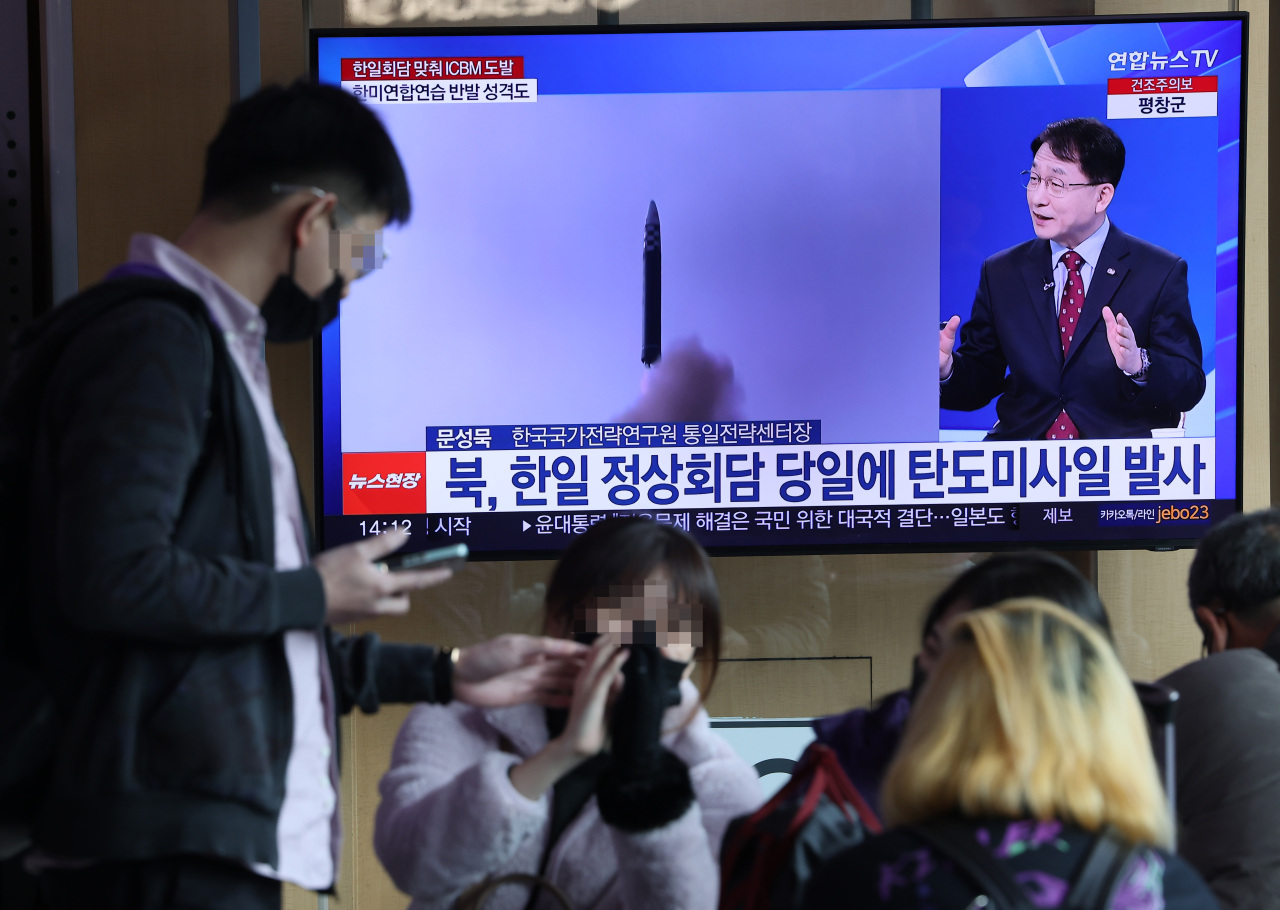N.Korea fires ICBM ahead of S. Korea-Japan summit
Seoul and allies commit to enhance security cooperation; Yoon warns Pyongyang
By Ji Da-gyumPublished : March 16, 2023 - 15:05

The South Korean military said the launch of the intercontinental ballistic missile, ICBM, was planned and intended to express North Korea’s “strong dissatisfaction” over the summit between President Yoon Suk Yeol and Prime Minister Fumio Kishida.
Holding an emergency national security council before leaving for Japan, Yoon said, “North Korea will certainly pay a price for its reckless provocation" and called for “further strengthening of security cooperation among South Korea, the US and Japan.”
South Korean, US and Japanese top nuclear envoys also underscored that North Korea’s ICBM launch before Yoon’s departure to Tokyo was a “grave provocation that has seriously heightened tensions in the region,” during a trilateral phone conversation, according to South Korea’s Foreign Ministry.
The three also committed to “continuously enhancing capabilities to overwhelmingly respond to nuclear and missile threats from North Korea by further reinforcing security cooperation among South Korea, the US, and Japan.”
The ICBM was fired from the Sunan area in the capital city of Pyongyang toward the East Sea at around 7:10 a.m., according to South Korea’s Joint Chiefs of Staff. The missile was launched about three hours before Yoon departed for Tokyo.
The ICBM traveled around 1,000 kilometers, following a lofted trajectory before falling into the East Sea, the JCS said, without further details. In an unusual move, the ICBM flew northeastward and splashed into waters near the border area between China and Russia.
Japan’s Defense Ministry said the IBCM appeared to have traveled for around 70 minutes with a maximum altitude of around 6,000 kilometers.
The South Korean military saw a high probability of North Korea firing the Hwasong-17 ICBM, given that missile specifications are analogous to previously launched Hwasong-17 ICBMs. But rigorous analysis is required to reach a conclusion as some data on the latest launch may differ from previous launches.
South Korean and US intelligence authorities have been analyzing the specifications of the missiles in light of North Korea’s development of its missile systems.
Experts said North Korea’s ICBM launch aimed to achieve the tactical goal of protesting against South Korea and the US' ongoing military exercises, which are the largest the two nations have staged in years. The launch was also a way of sending a warning message against enhancing security cooperation between South Korea and Tokyo.
But experts pointed out that launching an ICBM which is capable of reaching the US mainland will have the opposite effect, rather driving South Korea, Japan and the US to step up their security cooperation, as well as raising doubts as to whether North Korea considered the losses for its high-profile saber-rattling.
“North Korea’s missile launch seems to be a reaction to moves by South Korea and Japan to strengthen military cooperation, using the bilateral summit as a momentum, as well as to protest against the combined military exercises between South Korea and the US,” said Cheong Seong-chang, director of the Center for East Asian Cooperation at the Sejong Institute.
“But the show of force at this juncture will only backfire on North Korea by actually lending weight to the Yoon Suk Yeol government’s endeavor to reinforce bilateral military cooperation with Japan and trilateral cooperation with the US and Japan.”
At the meeting in the morning in Seoul, Yoon called for the 11-day Freedom Shield exercise that South Korea and the US kicked off on Monday to be conducted rigorously, underscoring the necessity of “intensively conducting combined military exercises, including planned air assault exercises and carrier strike group exercises.”
The US Navy’s Nimitz-class nuclear-powered aircraft carrier, which is one the world’s largest warships, is scheduled to be deployed to South Korea later in the month for combined maritime exercises with the South Korean forces.





![[From the Scene] Monks, Buddhists hail return of remains of Buddhas](http://res.heraldm.com/phpwas/restmb_idxmake.php?idx=644&simg=/content/image/2024/04/19/20240419050617_0.jpg&u=20240419175937)





![[Graphic News] French bulldog most popular breed in US, Maltese most popular in Korea](http://res.heraldm.com/phpwas/restmb_idxmake.php?idx=644&simg=/content/image/2024/04/18/20240418050864_0.gif&u=)



![[From the Scene] Monks, Buddhists hail return of remains of Buddhas](http://res.heraldm.com/phpwas/restmb_idxmake.php?idx=652&simg=/content/image/2024/04/19/20240419050617_0.jpg&u=20240419175937)

![[KH Explains] Hyundai's full hybrid edge to pay off amid slow transition to pure EVs](http://res.heraldm.com/phpwas/restmb_idxmake.php?idx=652&simg=/content/image/2024/04/18/20240418050645_0.jpg&u=20240419100350)

![[Today’s K-pop] Illit drops debut single remix](http://res.heraldm.com/phpwas/restmb_idxmake.php?idx=642&simg=/content/image/2024/04/19/20240419050612_0.jpg&u=)